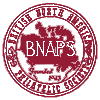- BNAPS Online Resources
Welcome to the Forum
Discovered something interesting or unusual? Want to share it with fellow collectors? Here's the place to do it!
Got a question about something in your collection? Here's the place to ask!
Doing research? Looking for information? Crowd source with your fellow collectors!
The Forum provides a platform for the exchange of ideas and information. To submit, contact the Webmaster, leopold.beaudet35@gmail.com.
The rules
- Stick to British North America philately.
- Be short and concise, but include relevant images.
- No buying, selling, or trading.
- No want lists.
2024-02-06 1934 3¢ Jacques Cartier
"Hairline from Arm" plate flaw - Richard Groves
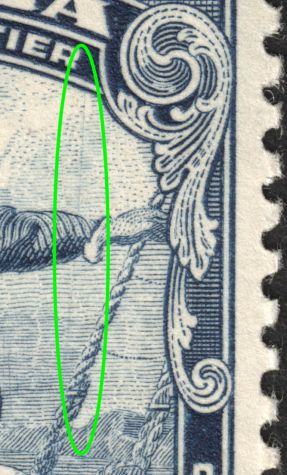
On 22 October 2020, David and Earl Noss reported the discovery of the "Hairline from Arm" plate flaw on the 1934 3¢ Jacques Cartier stamp. The flaw is similar to the "Hairline from Hand" flaw that is catalogued in the Unitrade Canada Specialized. The authors ask if anyone else has found a copy or knows its position.
I have a copy of this flaw in a mint block of four. The flaw is on the upper right stamp. This confirms that the flaw is not in the first column or bottom row of the pane.
I purchased the flaw as the Unitrade listed variety, but when I received it I realized the hairline was not in the correct place. Having read the 2020 report in the Forum, I am relieved to know that the "Hairline from Arm" is indeed a recurring plate flaw.
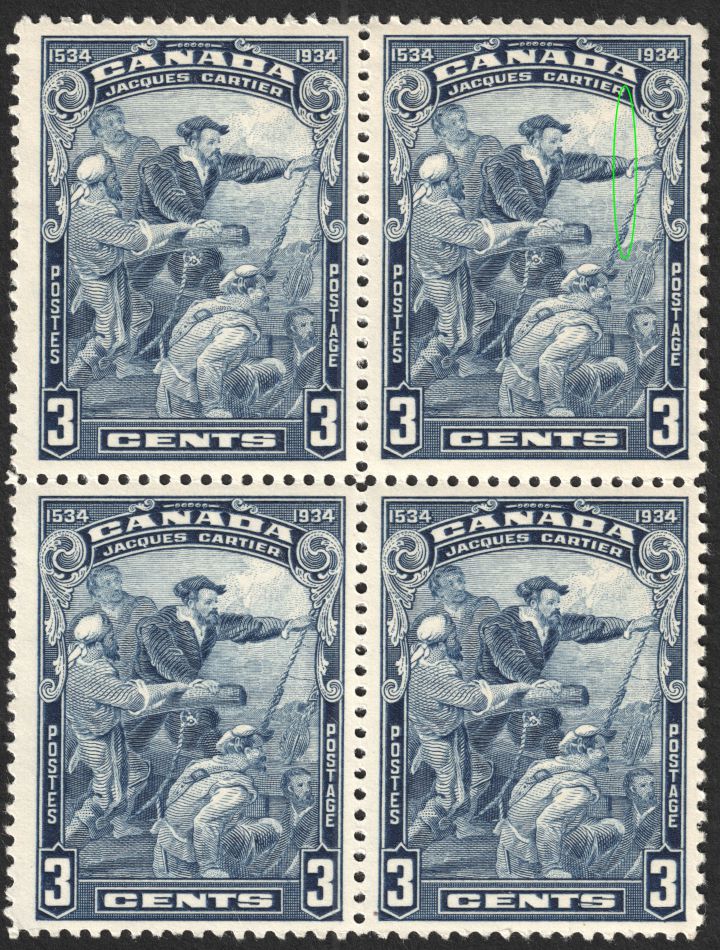
2022-08-11 1935 Silver Jubilee
13¢ Royal Yacht Britannia, misplaced entry - Earl Noss
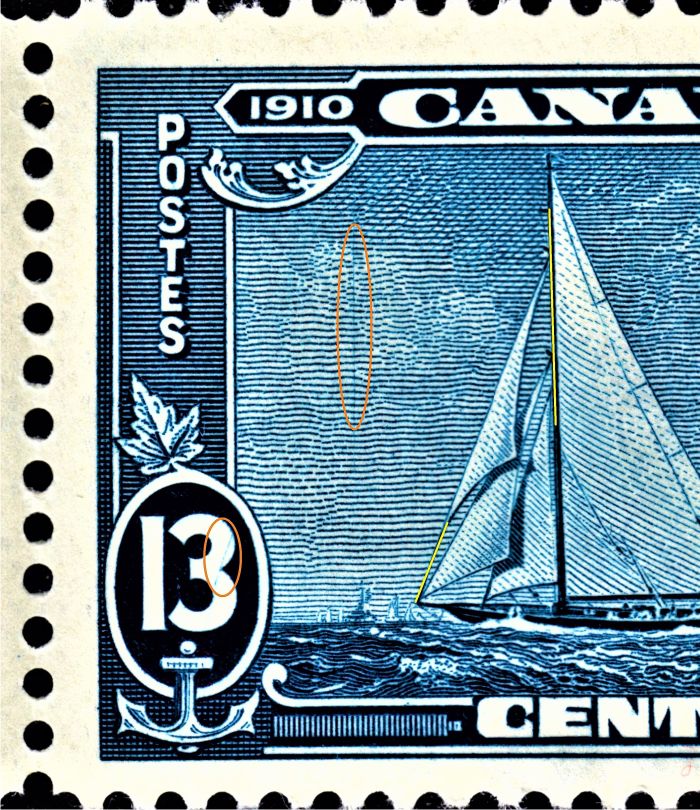
While examining a pair of the 1935 13¢ Royal Yacht Britannia commemorative, I found on the right hand stamp a long thin vertical line in the sky at left and a thin diagonal line in the 3 of the left value tablet. The lines are circled in orange in the illustration.
These two lines have counterparts in the design. As shown in yellow in the illustration, the vertical line corresponds to the yacht's mast and the diagonal line to the rigging at the bottom of a sail. The two lines appear to be due to a misplaced entry.
Does anyone have a copy of this variety? Can anyone provide its position?
2022-06-25 Postage Meter
1935 Meter with Strange Inscription on Hudson’s Bay Company Cover - Eugene Maynard

This Hudson’s Bay Company cover displays a 1935 scalloped postage meter frank. I am curious about the inscription above the franking:
“Winnipeg 10 plum inverted U-209”
It is most certainly not written with a typewriter. Could this be an imprint from the meter machine? What does it signify? Has anyone seen anything similar?
My email address is generoymaynard@gmail.com.
2022-02-14 ● 1935 Silver Jubilee
1¢ Princess Elizabeth, "Line through Medallion" - Earl Noss

The "weeping princess" plate flaw on the 1935 Silver Jubilee 1¢ Princess Elizabeth commemorative is a well known variety. It is the only catalogued flaw on this stamp; however, there are many more.
In his book, Canada Steel Engraved Constant Plate Varieties, Hans Reiche lists 52 flaws, including the "line through medallion" illustrated above. It is found on plate 2, lower left pane, stamp 54 (row 6, column 4). Most of the flaws Reiche describes are small, but this one is quite prominent.
The flaw is on the upper left stamp in the block of six, which I acquired recently from an eBay dealer.
2021-10-07 ● 1911 Admiral Issue
2¢+1¢ carmine perf 12x8 ERD - Louis Arpin

The Admiral 2¢+1¢ carmine perf 12x8 was produced from coil stock reportedly because of a shortage of perf 12 sheet stamps. Illustrated above is a copy with an RPO postmark that reads: LEVIS & CAMP'B'TON EXP.-R.P.O./. The postmark is dated JUL 23 / 16, the earliest recorded date for this stamp.
The cancel is listed as QC-59 in the Ross Gray Catalogue of Canadian Railway Cancellations and Related RailwayPostmarks including Selected Waterway Postmarks, 2nd edition. The first edition listed it as Q-38. The hammer was in use from 22 Jan. 1915 to 6 June 1961.
Leopold Beaudet, editor of the Admiral Study Group's newsletter The Admiral's Log, listed reports of other early dates:
- 24 July 1916 - on cover mailed from Quebec City to Ottawa, sold on eBay by "back2paul" in June 2015
- 27 July 1916 - reported by George C. Marler in his 1982 book, The Admiral Issue of Canada, p. 449
- 28 July 1916 - reported by the War Tax Study Group (active in the 1950s, chaired by Hans Reiche) in its 1959 handbook, Canada The War Tax Stamps, p. 23.
2021-08-09 ● 1911 Admiral Issue
2¢ carmine sidewise coil ERD - Brian Murphy
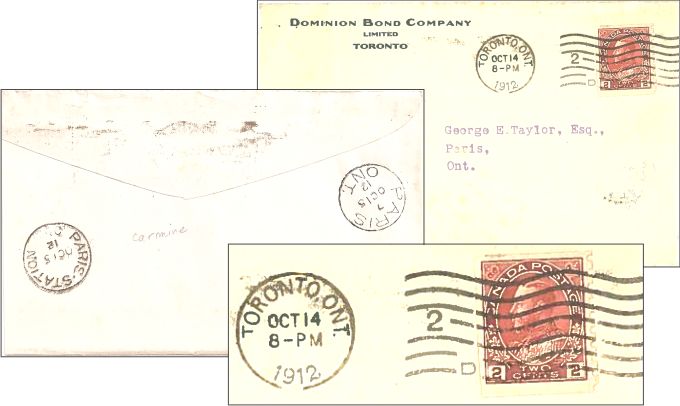
The Admiral 2¢ carmine sidewise coil on the cover above has a Toronto cancel dated 14 October 1912. Two backstamps, one from Paris, ON, and the other from Paris Station, both dated 15 October 1912, confirm the date on the front.
In his 1982 book, The Admiral Issue of Canada, George C. Marler quotes a Post Office memorandum saying that “In September 1912, the Department began to issue stamps in rolls” (page 311). He owned a 2¢ carmine coil stamp with a slogan cancel “advertising a welfare exhibition to be held on October 8th to 22nd, 1912” (page 313), but his earliest dated example is 20 February 1913 (page 314).
Is the cover with the 14 October 1912 date the earliest recorded date (ERD) for this coil stamp? And what is the ERD for its companion, the 1¢ green sidewise coil? I posed these questions to Leopold Beaudet, editor of the Admiral Study Group newsletter. His reply:
The earliest dates I have recorded for the 2¢ carmine sidewise coil are 20 Oct. 1912 (on stamp) and 23 Oct. 1912 (on cover). The 23 Oct. 1912 date was reported by Allan Steinhart in BNA Topics, July-Aug. 1978, page 11. Your cover with a date of 14 Oct. 1912, is thus the earliest example I know of.
The earliest dates recorded for the 1¢ green sidewise coil are 27 Sept. 1912 (reported by Rick Parama on a postcard with a receiver dated 29 Sept. 1912 – see BNA Topics, Sept.-Oct. 1979, page 26), 10 Oct. 1912 (reported by Harry Lussey on a single stamp – see Marler, page 193), and 10 Oct. 1912 again (another Lussey report, this time on a strip of four – see BNA Topics, July-Aug. 1976, page 11). There are at least three distinct 18 Oct. 1912 reports from Parama, Lussey, and Ann Dorian, all on cover.
Does anyone have Admiral 1¢ or 2¢ sidewise coils with earlier dates?
2021-06-03 ● 1897 8¢ Maple Leaf ● Re-entry
1897 8¢ Maple Leaf 1R10 re-entry - Earl Noss
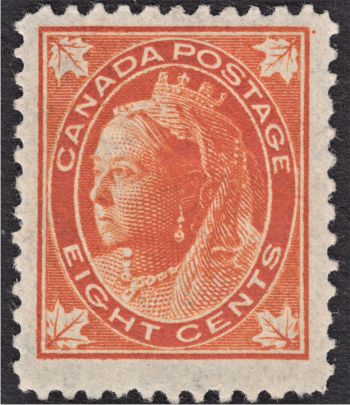

Illustrated is a re-entry on the 1897 8¢ Queen Victoria Maple Leaf definitive. There is doubling in CAN and the oval above the N. I have three copies, proving that it is constant, and have seen a fourth copy with pane selvedge at the top, providing a clue as to its position. Another clue is the dot in the upper right corner, which occurs on all copies.
David McLaughlin, a noted specialist of the Maple leaf issue, identified the position. He writes: "It is position 1R10 [that is, plate 1, right pane, row 1, column 10], and it is a constant variety that can be found on the plate proofs at Library and Archives Canada. I have been able to find it on individual stamps, a 1R9-1R10 imperf corner pair, and a 1R9-1R10-1R19-1R20 mint block. The dot in the upper right corner is a standard guide dot used for plate layout."
He adds that "the other constant variety on this stamp is the re-entry on 1R69 with a line through the top of letters in CANADA. I have found singles on both vertical and horizontal wove paper, an imperf pair, and a mint block." This re-entry is illustrated on Ralph E. Trimble's re-entries website (see https://re-entries.greenefoundationarchive.ca/maple_leaves_eightcents.html, stamp #1), and is listed in the 2021 Unitrade Specialized Catalogue of Canadian Stamps.
2021-03-08 1851 3d Beaver ● Plate flaw
Railway tracks flaw on 1851 3d Beaver - Earl Noss
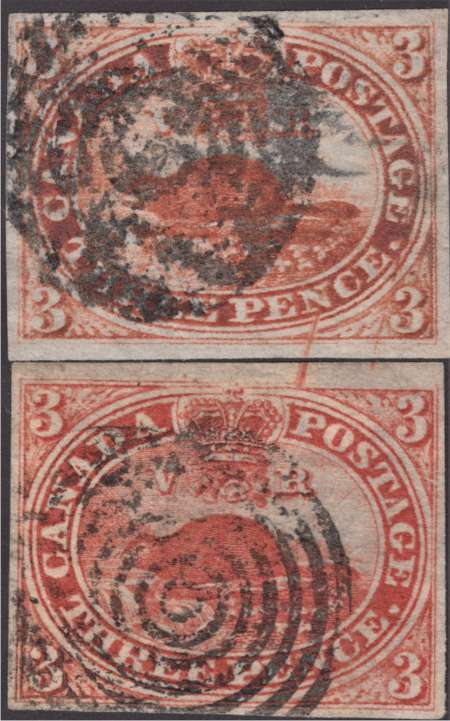
I recently acquired an 1851 3d Beaver stamp with two diagonal lines in the top margin at right (the bottom stamp in the illustration). Dr. Jim Watt informed me that this was a constant plate flaw known as the "Railway tracks" flaw, and Michael D. Smith and Jim Jung confirmed it. The flaw occurs on pane A, stamp 41.
Looking through my collection, I found the other half of this flaw on stamp 31 (the top stamp in the illustration). Both stamps are on thin paper. The flaw occurs on proofs of this stamp.
2020-10-22 1934 3¢ Jacques Cartier ● Plate flaw
New plate flaw on 1934 3¢ Jacques Cartier - David and Earl Noss

Here is a newly discovered plate flaw on the 1934 3¢ Jacques Cartier commemorative, the "Hairline from Arm". It consists of a hairline above and below Cartier's arm.
A similar flaw, the "Hairline from Hand", is well known and is catalogued in the Unitrade Canada Specialized. It occurs on plate 1, right pane, position 89 (row 9, column 9). If you have a lower right plate block from plate 1, you have the flaw.
Has anyone else found the "Hairline from Arm" plate flaw? Does anyone know its position?
Illustrated below are the "Hairline from Arm" on the left and the "Hairline from Hand" on the right.
2021-01-02 Flaw confirmation by Randall W. Van Someren
Randall has a copy of the "Hairline from Arm" flaw in his collection. He's had it for some time, but is still looking for the catalogued "Hairline from Hand" flaw.
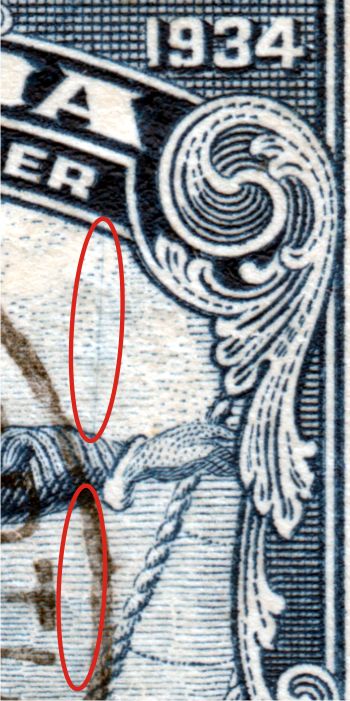
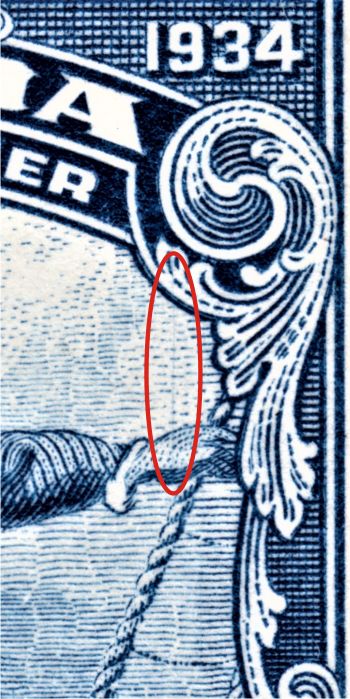
2020-10-22 Revenue stamps ● 1914 Customs Duty ● Re-entry
Major re-entry on 5¢ 1914 Customs Duty revenue stamp - Earl Noss

Quite a few years back, I found two copies of this re-entry on the 5¢ 1914 "Crown" Customs Duty revenue stamp printed by the American Bank Note Co. I reported it in the Sept. 2020 issue of the Canadian Revenue Newsletter published by the BNAPS Canadian Revenue Study Group. To my knowledge, it had never previously been reported.
The re-entry is visible in the upper left corner of the design. The left half of the top frame, the "CA" in CANADA, and the dot to the left are all noticeably doubled.
Has anyone else seen this re-entry or any other on this stamp? How about the other three values of the 1914 issue - the 1¢, 2¢, and 10¢?

2020-10-22 Admiral Issue ● 3¢ carmine ● R-GAUGE
Admiral 3¢ carmine with R-GAUGE - Gary Steele and Leopold Beaudet
Late in 1916, American Bank Note Co. (ABN) began engraving strips of lathework in the bottom sheet margin of Admiral stamps. In March 1922, ABN added pyramid lines in the left or right sheet margin, and, in November 1922, the inscription "R-GAUGE" in the other side margin. ABN did the same for postage due and revenue stamps. It is generally accepted that the lathework served as hold-down strips and the pyramid lines as a perforation guide, but the purpose of the R-GAUGE inscription is still unknown to this day. ABN eliminated these marginal markings when it switched from the wet to the dry printing method between 1923 and 1926. The markings are highly sought-after by Admiral collectors.
The R-GAUGE inscription is most common on the 3¢ carmine (perf and imperf). Next most common are the 5¢ violet and the $1.00. Much scarcer, with just a handful known, are the 10¢ blue, 50¢, and 2¢ green. The inscription was placed in the right sheet margin. The one exception is plate 22 of the 5¢ where it occurs in the left margin.
Shown here are two used pairs of the R-GAUGE on the 3¢ carmine. One has a Winnipeg & Swan River RPO cancel dated "JU 26 / 30", and the other a large "REGISTERED" cancel.
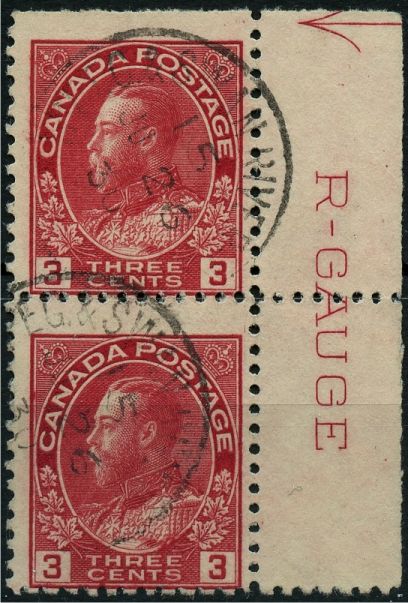
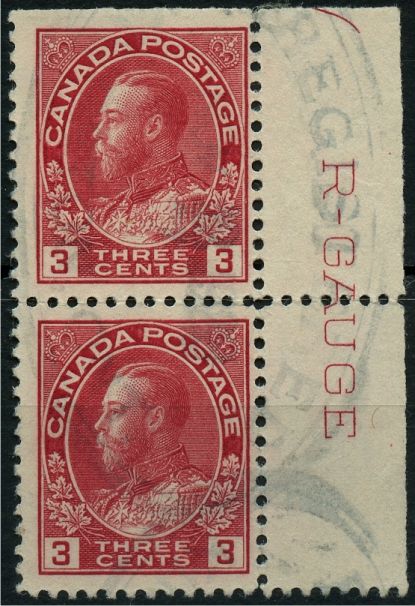
2020-10-11 1898 1¢ Numeral Issue ● Re-entry
Major re-entry on the 1898 1¢ Numeral Issue - Earl Noss
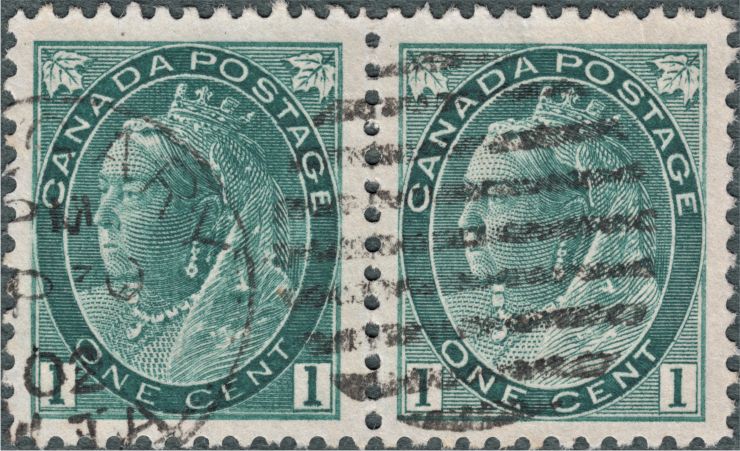
Here's an item I won on eBay. The left stamp in the pair has a major re-entry affecting the bottom half of the stamp. It shows very strong doubling of the Queen's neck, headscarf, and dress. The letters ONE CENT are thin. The lower spandrels and numeral boxes, notably the left, are doubled. The doubling extends as high as the left margin opposite the C in Canada and the E in postage.
No one I contacted had seen this re-entry before. The 1¢ was printed from 12 plates, several of which exist in more than one state of repair. The date in the cancel is [?]P 30 / 02. Peter Spencer, the author of the BNAPS book The Wearing of the Green believes the pair comes from plates 5B-8B ("B" indicating the second state of the plates). Stamps from this state were used mostly in the first half of 1902.
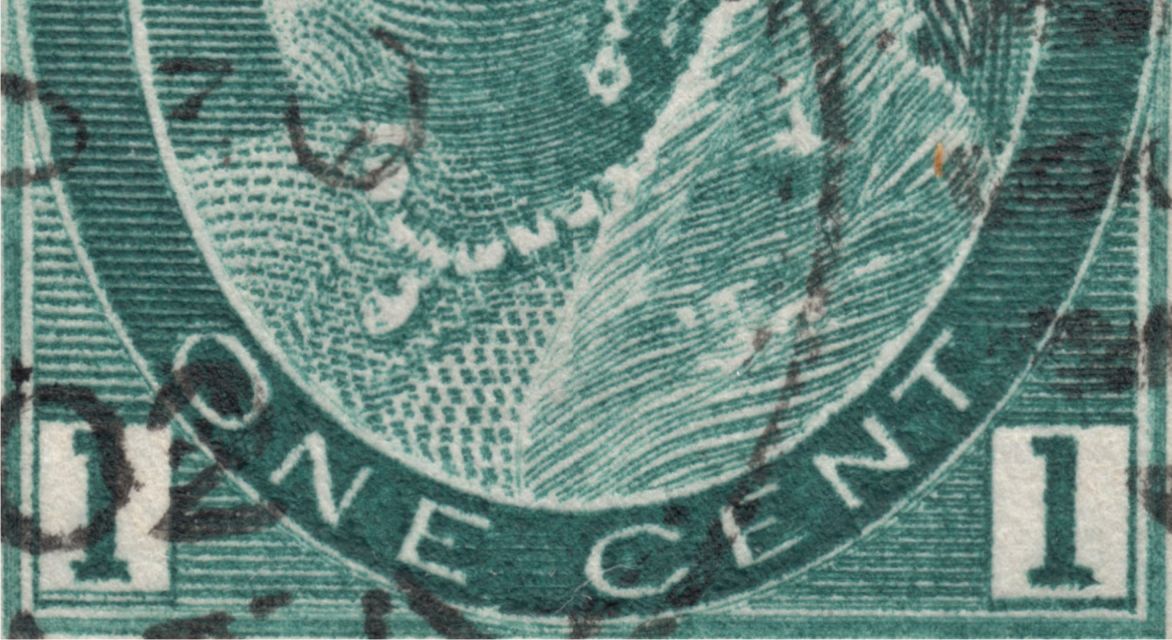
2020-09-30 1911 Admiral Issue ● 3¢ brown ● Re-entry
Misplaced entry on the 3¢ brown - Earl Noss and Leopold Beaudet
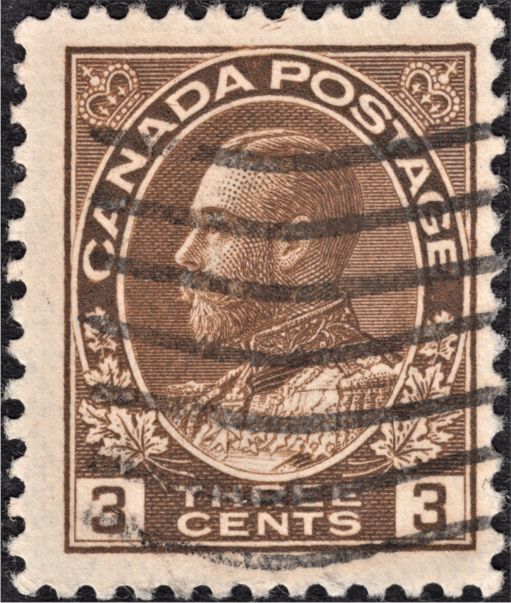
Earl Noss
I acquired this 3¢ brown Admiral stamp on eBay along with a second copy showing the same marks.
I'm thinking this may be a misplaced entry. The three marks in the top margin may be from the left
side of the top inner oval and the bottom of one of the letters. There is also a dot in the outer oval
above the D in CANADA and a line in the D. See marked-up image below. I also see a couple of dots in the
jewels of the right crown.
Leopold Beaudet
I reproduced the marks in black, and then shifted them around to see if they overlaid elements of
the design. The shifted marks, coloured blue in the image below, match the design quite nicely.
I think this strongly supports Earl's misplaced entry theory.
Is it possible to plate this stamp? The 3¢ brown was printed from almost 120 plates, each containing four panes of 100 stamps; however, Earl's stamp has a rough right frame that is characteristic of Marler's design type 1 (plates 1 to 6). There is a shallow dent in the top frame above the right crown (circled in the image below). This dent, or a bulge where the dent was retouched, occurs on multiple stamps from plates 2, 3, 5, 82, 88, 89, and 96. This implies that the stamp comes from plates 2, 3, or 5.
Library and Archives Canada has the plate proofs of all the Admiral stamps, and makes them available to researchers. On these proofs, I found the misplaced entry on plate 2, lower right pane, row 3, column 3, so the position is 2LR23. The diagonal lines in the top margin stood out on the plate proof.
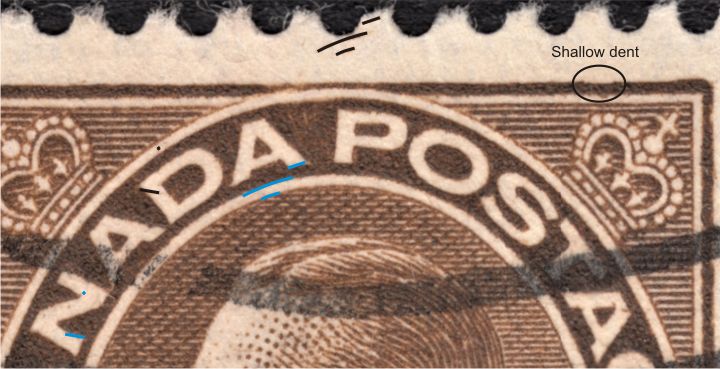
2020-09-19 1911 Admiral Issue ● 2¢+1¢ brown coil ● Re-entry
Re-entry on the 2¢+1¢ brown sidewise coil - Earl Noss
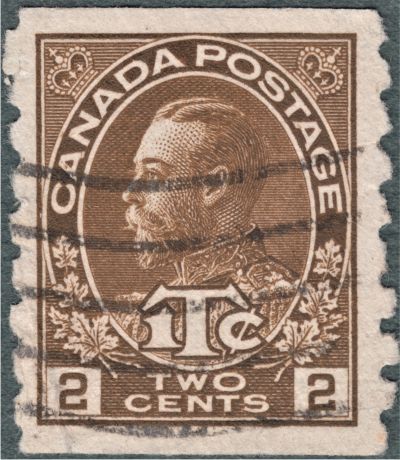
This Die II 2¢+1¢ brown sidewise coil has a re-entry consisting of extra marks in the AN in CANADA and A in POSTAGE. The marks are circled in the magnified images.
Referring to Marler's 1982 book, The Admiral Issue of Canada, the design type appears to be SR4 (no break in the vertical line in the left numeral box; break in the lower right vertical line above horizontal line 9 counting from the top of the right numeral box). This design type occurs on plates 7 and 8.
Marler reports finding "... marks in some of the letters of CANADA POSTAGE in five subjects on Plate 8 ..." (page 464). Unfortunately, he does not describe the re-entries in any more detail or provide the position of the five subjects on the plate.
This stamp may well be one of the five. Does anyone have an example of any of the other four?


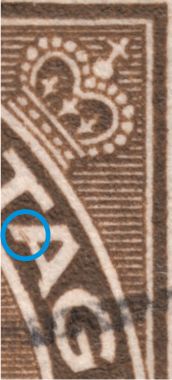
2020-09-12 Postal History ● Wax Seal
Canadian Government Department Wax Seal Handstamps - Gary Steele
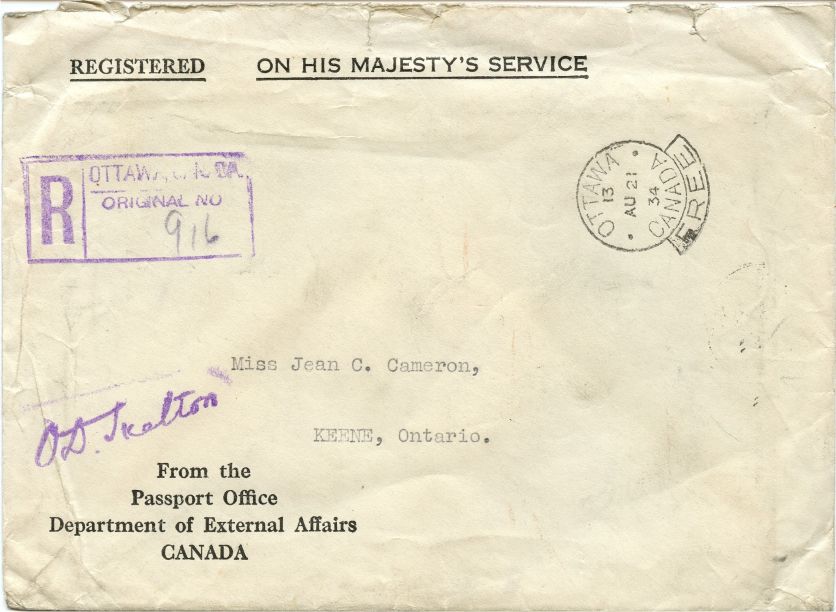
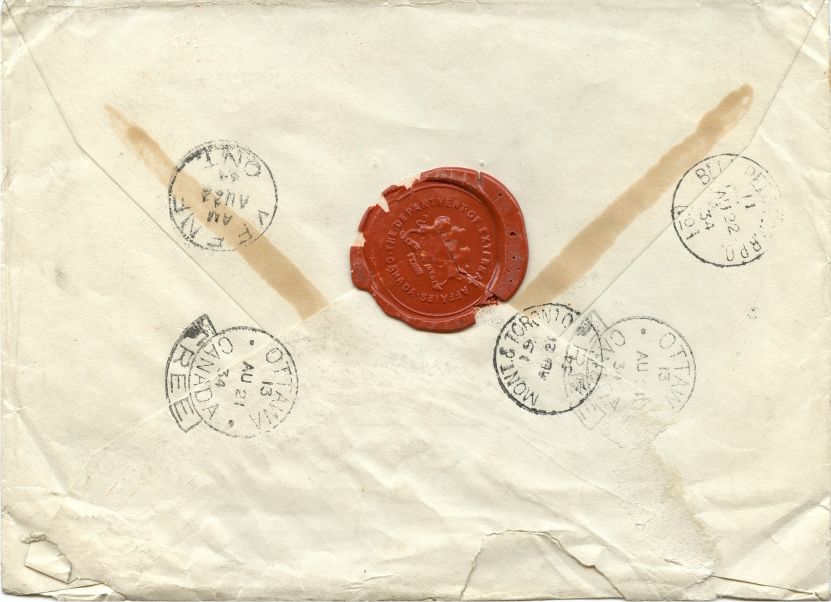
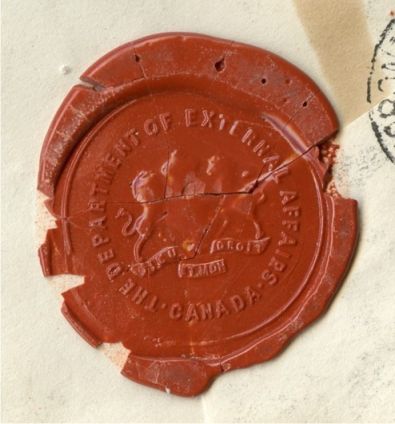
Close to my Canada Post Office Wax Seal handstamps are the Government Department Wax Seals. Such as Censorship (Post Office and Government), Dept. of External Affairs (as shown), RCMP, and many others.
Note that the FREE franking shown here includes the Registration fee and regular first class postage.
Although the Government Wax Seals are made by brass seals similar to those of the Post Office, Departments use them mainly for security reasons to seal envelopes of value or importance.
I am interested in seeing any examples of Wax Seal handstamps, either Post Office or this type. Please email gwsteele57@gmail.com.
2020-08-14 Postal History ● Cancels
Census of RPO and Squared Circle Map Stamp covers - Rick Friesen
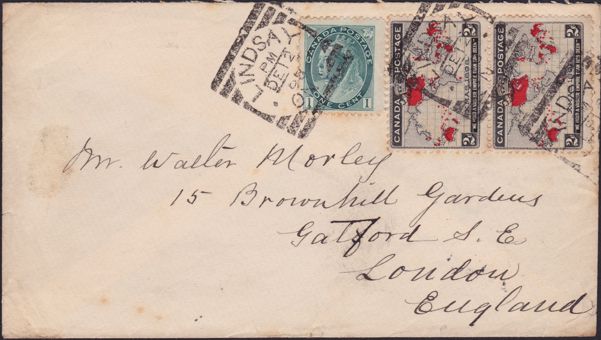
I am compiling a census of 1898 Map Stamp covers with RPO and Squared Circle postmarks. The project has been ongoing for about 5 years. When "complete", I intend to publish the information on the BNAPS website (similar to the way in which the latest edition of the Squared Circle Handbook is available).
Thus far, information has been supplied to me by members of the BNAPS RPO and Squared Circle Study Groups, but I would like to extend the request for information to a larger collector base. If you have a Map Stamp cover in your collection with either an RPO or a Squared Circle postmark (on the front or as a backstamp on the reverse of the cover), I would very much like to know about it so that it can be added to the database. The best way to submit the information about the cover is to send me a scan/image of the cover itself.
All contributions will be acknowledged in the publication unless you would prefer to remain anonymous, in which case your name will be withheld. Please contact me by email at: rickfriesen5@gmail.com.
2020-07-04 Postal History ● Wax Seal
SAINT ROCK Canada Post Crown Wax Seal - Gary Steele

Over the last few months, I have been trying to locate information on where this Canada Post Wax Seal may have originated. The name on the Wax Seal is SAINT ROCK, and there is a crown in the upper part.
My guess is this item is from 1820 to 1860 approximately. As there is no UC, LC, CE or CW, it may actually be earlier.
As place names changed over the decades and spelling changes occurred also, I am at a loss. Internet searches seem to come up with SAINT-ROCH in Quebec City. So this could just be the English spelling being used.
Does anyone have any cancellation or cover to give an idea of where this Wax Seal may have originated? Having it on the original cover would have made my search much easier.
I am looking for any and all information on Canada Post Office Wax Seals including examples if available. They also exist for various Post Office departments such as Accounting, Inspection, Dead Letter Office, the RPO division, and others. Please contact me at my email address: gwsteele57@gmail.com.
2020-06-25 Postal History ● Newfoundland ● Military Mail ● World War II
HMCS Avalon triangular marking - John Cranmer

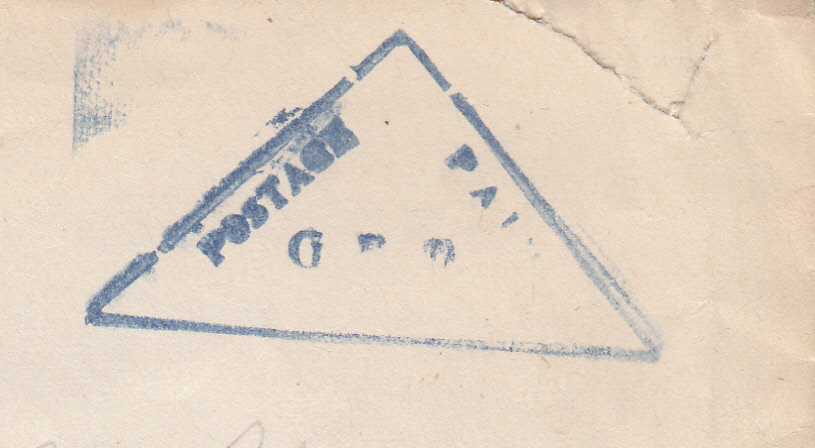
Paul Binney wrote a two-part article in the Apr.-June and Oct.-Dec. 2012 issues of BNA Topics about the triangular markings used at the Royal Canadian Navy base HMCS Avalon. The base was established in St. John's, Newfoundland, during World War II.
The article is entitled "A re-examination and classification of the GPO Triangles on naval mail from HMCS Avalon, St. John’s, Newfoundland", It describes five different types of GPO rubber hammer markings and constant variations in those markings. I have not seen anything more recent on this subject.
My collecting interest is Canada, mainly King George VI and World War II in particular. This includes Canadian forces abroad. I have just found an example of the HMCS Avalon triangular marking on a cover dated 1942. It corresponds to the type Binney classifies as GPO2.
In his article, Binney describes four sub-types of the GPO2 Avalon cachet based on cuts deliberately made to the sides of the triangle. However, this example does not fit any of Binney's sub-types. It appears to fit between type 2a with only one cut and 2b with five. It clearly does not have the large cut in the base, but has two cuts on the left and one on the right.
There are no markings, dates or return address on the back of the cover.
Is this a well-known variety? If so, please let me know. My email address is john.cranmer@ntlworld.com.
2020-05-25 Postal History ● Rates ● 1967 Centennial Issue ●
10 cent UPU Surface Letter Rate in 1967 - Brian Murphy
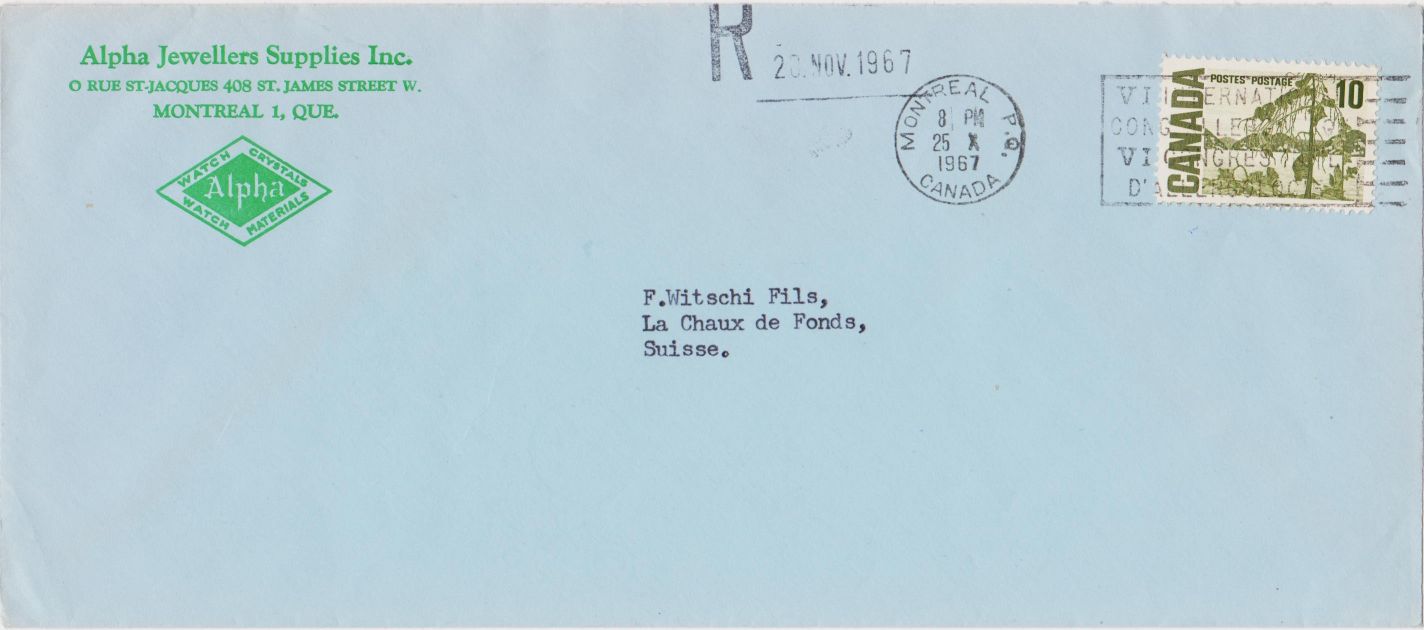
This cover, from Montreal 25 October 1967, is paid 10¢ correctly – Canada’s UPU surface letter rate, 1 January 1966 until 1 November 1968. By the Centennial era, Canadians rarely used surface mail. Almost all letters to Europe were sent at the 15¢ per ½ oz air mail rate. So this cover is a correct rare rate!
Indeed, as a measure of the rarity of correctly paid UPU surface letters at this time, they are rarer than UPU letters underpaid at the 5¢ domestic rate. That is, Canadians more frequently unknowingly stamped their UPU letters at the domestic rate than they consciously chose and paid this 10¢ UPU rate!
This cover is made rarer – and more desirable – by the Swiss receiver of 28 November 1967 above the Montreal cds. That receiver reveals that the cover was 34 days in transit! Airmail at the time was 15¢ and usually about three days! So for that month delay, the sender saved 5¢! (More precisely, they might have saved 20¢, as the 10¢ surface letter was up to a full ounce, and the 15¢ air letter only a half ounce.) Most correspondents thought an extra 5¢ was worthwhile to get their letter to Europe a month earlier!
So the receiver allows a fuller understanding of why the 10¢ surface rate is rare, and why it soon disappeared. The 5¢ cost was so little extra and the delay, of up to a month, so long that sea mail was rarely used, and Canada abolished First Class sea mail on 1 July 1971.
2020-05-20 Postal History ● KG VI
Multiple Postage Due cover to Australia - Gary Steele
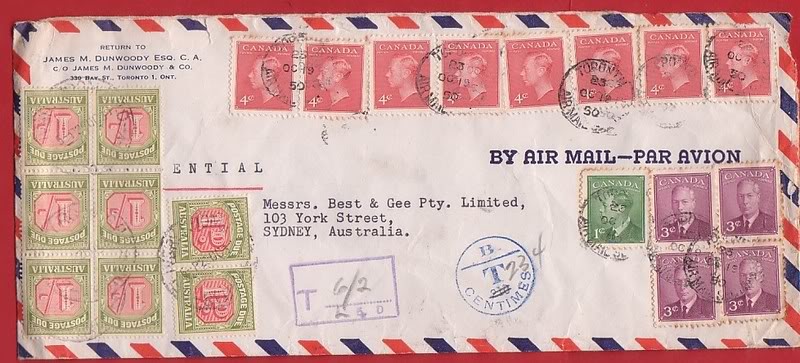
Here is a cover that is closer or was closer to home for the Aussies.
Mailed OC 19 1950 with 8 x 4¢, 4 x 3¢, and 1 x 1¢ definitives, all from the 1949 KG VI issue with Post Postes, for 45 cents total payment. The cover was originally charged 210 centimes due probably from Canada, then changed to 234 (blue circular marking).
A proper 3/4 ounce weight should have been charged 3 x 25¢ per 1/4 oz for 75¢ total or 1 ounce x 25¢ per 1/4 oz = $1.00.
(210 centimes / 2 double deficiency) / 3 centimes per cent = 35 cents short-paid
(234 centimes / 2 double deficiency) / 3 centimes per cent = 39 cents short-paid
The best guess I can make is the cover was up to 3/4 of an ounce in weight x 25¢ per 1/4 oz would have been a 75¢ charge with payment of 45¢ short-paid 30¢ CDN.
30¢ CDN x 2 double deficiency = 60¢ x 3 centimes per cent = 180 centimes due.
Payment by Australian boxed T (I assume) was 6s 2d (purple rectangular marking).
If anyone has any other explanations or points of interest for this cover, I would appreciate hearing from you via email as this is one of the haunts of collecting this type of material. Sometimes you just never know why a certain amount of postage due was charged other than maybe someone calculated wrongly. My email address is gwsteele57@gmail.com.
2020-05-18 Postal history ● Cancels
Back to the Past - Leopold Beaudet
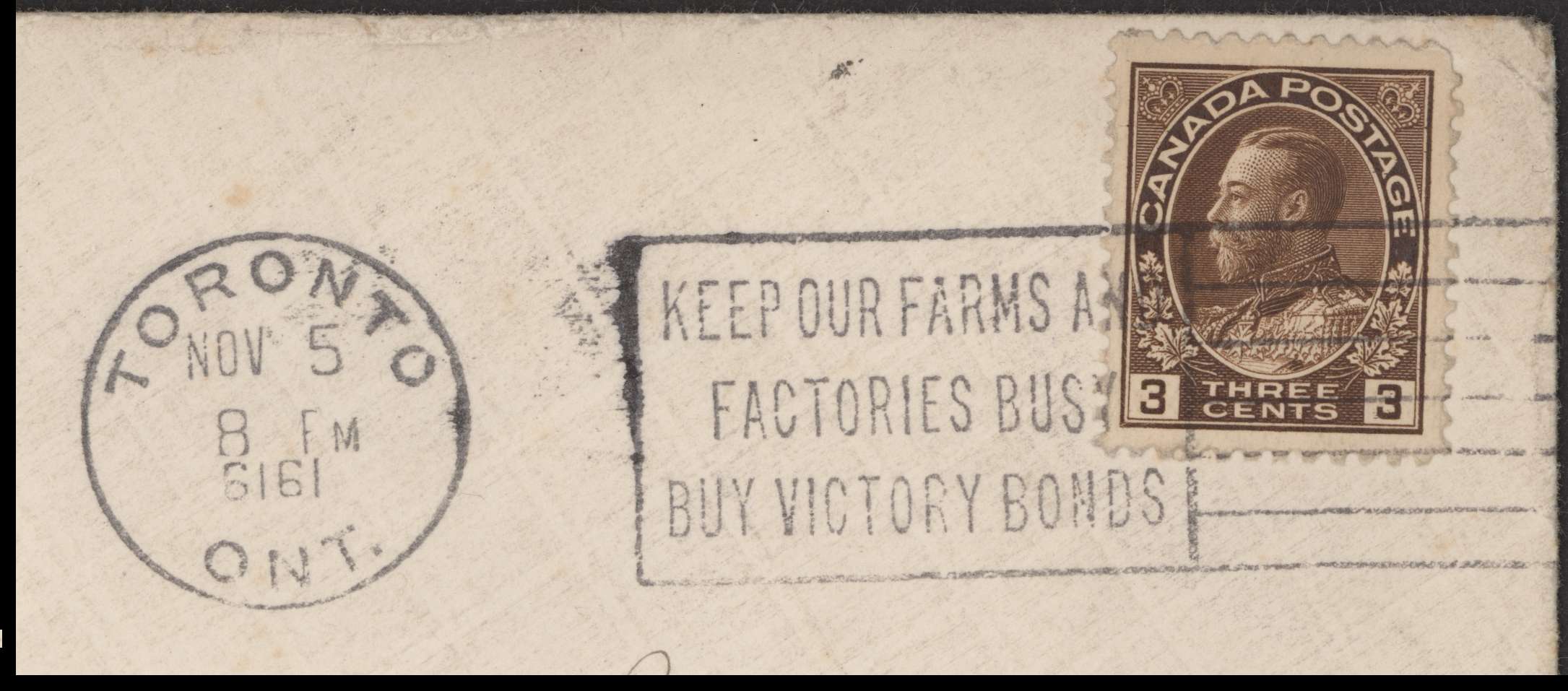

In 6161, just slightly more than four millennia after Admiral postage stamps were first issued, Canada Post decided to cater to the interests of a new generation of Admiral collectors. Having ascertained that four millennia had been unkind to most of the precious treasures that collectors had preserved when Admiral stamps were first issued in the early 20th century, Canada Post, harnessing the absolute latest in replication technology to ensure breathtaking verisimilitude, reissued selected stamps from those haloed definitives.
Postal history collectors will be delighted to learn that Canada Post went the extra parsec by also recreating the ancient practice of physically delivering messages written on parchment to complement the reissue. These messages were inserted into enclosures also of parchment.
Following the quaint custom of that era, Canada Post affixed an Admiral stamp in the top right corner of each enclosure, and defaced it with a black mark called a “postmark” that was intended to prevent its reuse. In a remarkable display of assiduous research, they reconstructed a machine from that bygone era that automatically applied the postmark on the stamp.
A truly timeless collector’s item.
Reprinted from The Admiral’s Log, Vol. XII, No. 1, Dec. 2010.
2020-05-14 Postal history ● Cancels ● Diamond internal handstamp - Gary Steele
Diamonds may be forever, but not common.
My tally of approximately 6,000 Canada Post internal handstamps up to 1975 includes 31 different designs and borders. One of the least common in all areas of Canadian philately are diamond shaped handstamps.
This particular handstamp, measuring 53 x 35 mm, is also interesting in that the lettering is curved at the top and bottom lines. Most others usually follow the borders in a straight line.
The border of this handstamp is a single frame, but diamond shaped handstamps can also have a double border frame.
They are usually used on internal Post Office communications, papers, cards, forms, slips and envelopes as this item. The handstamp reads:
DISTRICT SUPERINTENDENT POSTAL SERVICE
JUN 23 1931
LONDON, - ONT.
I am compiling a handstamp database. Collectors owning similar handstamps can send me their scans with handstamp dimensions in millimetres. My email address is gwsteele57@gmail.com.
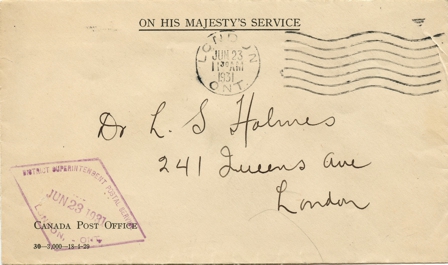
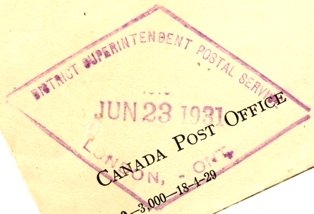
2020-05-12 KE VII ● Canadian Coronation Contingent - Keith MacKay
Stamp and shoe dealer Harrison "Harry" L. Hart sent this cover to his younger brother, Walter Hart, a private in The 63rd Halifax Battalion of Rifles. It appears that Walter was a member of the Canadian Contingent attending Edward VII's coronation in London, England. The coronation ceremony was scheduled to take place on 26 June 1902, and Harry's cover was postmarked on that date at the Gottingen Street Post Office (what a coincidence!).
However, the coronation ceremony was postponed at the last minute due to a problem with Edward's health that required surgery. It was rescheduled to 9 August 1902. On July (8/9?), the cover was posted in London back to Harry Hart at 71 Gottingen Street, arriving in Halifax on 18 July.
Can anyone refer me to a source that lists the members of the 1902 Canadian Coronation Contingent and the Halifax Rifles? You can contact me by email at keithmackay@eastlink.ca
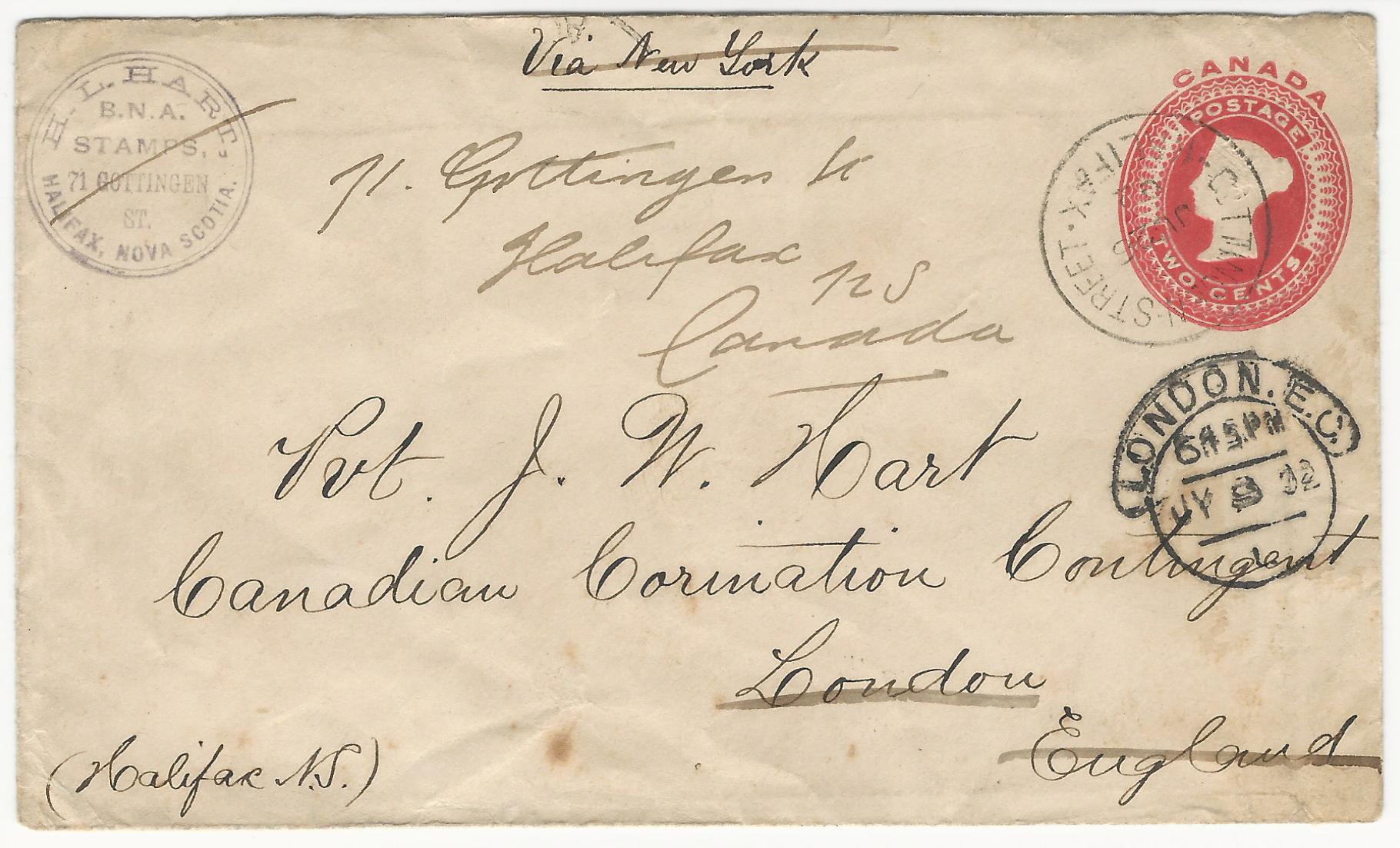
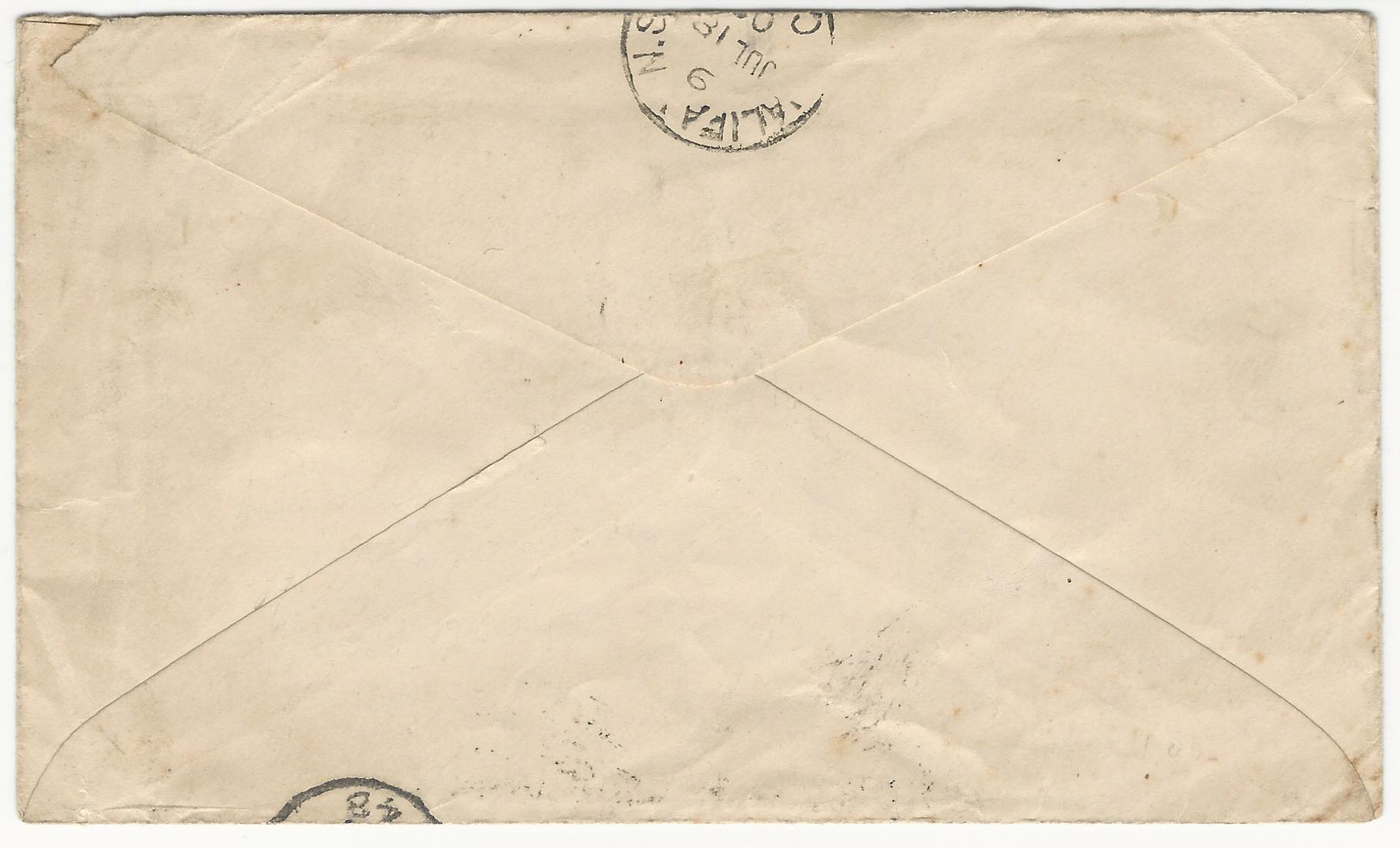
2020-04-09 Newfoundland ● Bileski notes - John M. Walsh
Alfred John Hubbard was Managing Director of Perkins Bacon & Co., a stamp printer that produced a number of Newfoundland stamps. Hubbard was also a distinguished philatelist. He was President of the Royal Philatelic Society from 1970 to 1973, and was invited to sign the Roll of Distinguished Philatelists in 1973.
After Hubbard died in 1976, his estate sold his philatelic holdings of Newfoundland to famed Winnipeg dealer Kasimir Bileski. Bileski sold at least some of the Newfoundland material in lots. With each lot, he included a handwritten or typed description such as the note shown at right.
I am interested in receiving scans of these notes. Perhaps you have acquired one of Bileski's lots and saved the accompanying note. If so, I would appreciate your sending me a scan. I'm particularly interested in Bileski’s notes on the 1938 Royal Family 2 cent and 7 cent denominations.
Send your scan to info@nfldstamps.com. Thank you.

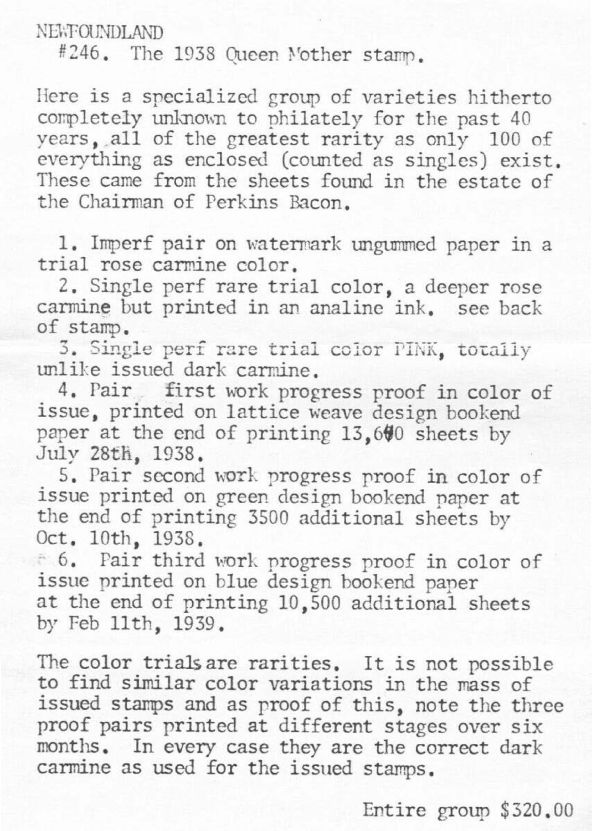
2020-04-06 Canada ● Admiral issue ● Booklet with 2¢ green - Leopold Beaudet
The Admiral booklet containing two panes of six 2¢ green stamps with the coat of arms on green covers is scarce. There are English and French booklets. Both have several cover varieties:
-
Coat of arms printed by engraving. Two ink colours reported: green and black.
Binding tape on cover. Information sheets inside have sans serif letters and War Tax info. - Same as above, but with no binding tape on cover.
-
Coat of arms printed by typography using black ink.
No binding tape on cover. Large slogan information sheets inside. -
Coat of arms printed by typography using black ink.
No binding tape on cover. Small slogan information sheets inside.
If you have any of these booklets, I would appreciate a scan of the cover, preferably at 1200 dpi. Contact leopold.beaudet35@gmail.com.

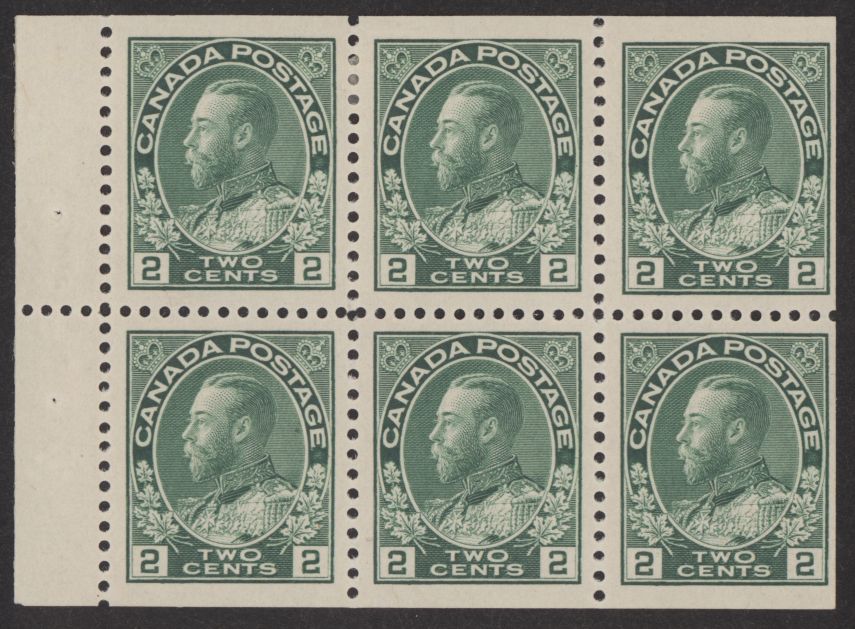


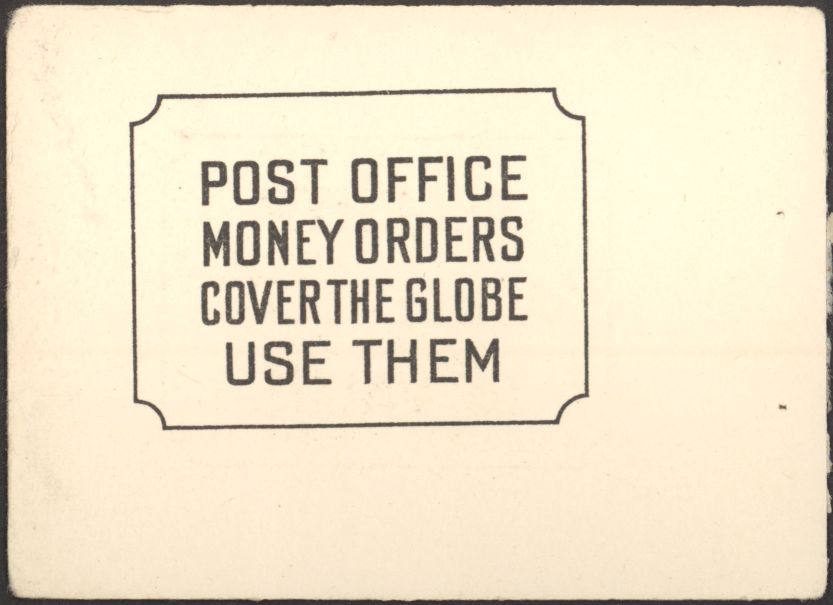
2017-02-11 Newfoundland ● Money Order Office Number (MOON) cancels - Mike Sagar
Over the past 20 years, I have been chronicling the Money Order Office Number (MOON) cancels of Canada, I have produced six handbooks on MOON cancels, and I am planning within the next few months to release one on the MOON cancels of Newfoundland, Military, Northwest & Yukon Territories, Transportation, and Events.
I have about 900 MOON cancels of Newfoundland listed (1950-1973), but would appreciate hearing from BNAPS members interested in contributing to my project or who may have items that can aid my research.
I am interested in different hammers, early and late dates, and even ink colour. Cancels can be on cover, card, stamp, or post office paperwork like receipts. Philatelic or commercial usage - I don’t care.
Collectors can send me their scans by email or photocopies by mail, preferably by 31 March. Anyone contributing will be acknowledged in the introduction of the handbook that is planned for release this May.
Michael Sagar
Email: gailandmike@shaw.ca

53874
Lance Au Loup, NL
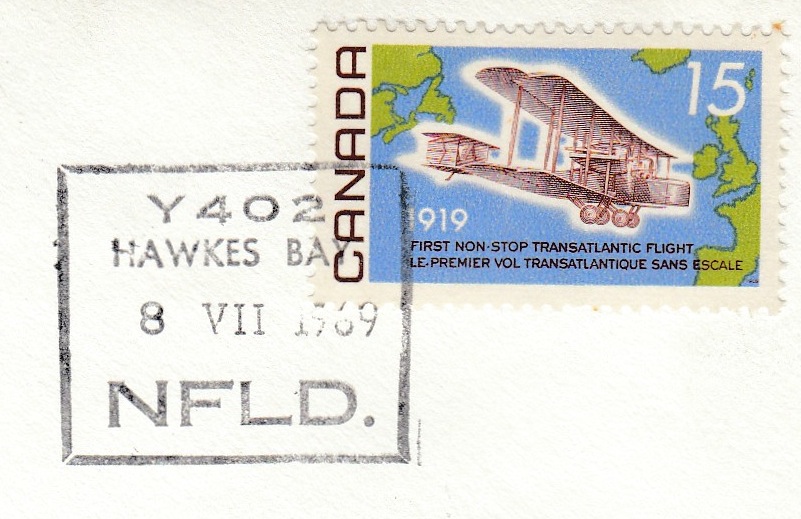
Y402
Hawkes Bay, NL
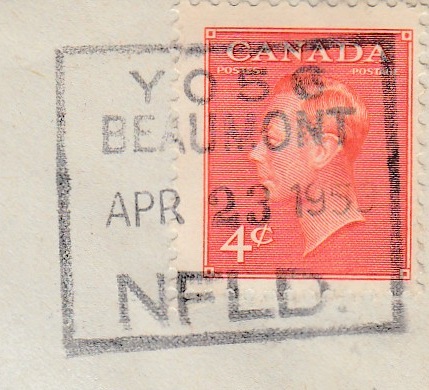
Y056
Beaumont, NL
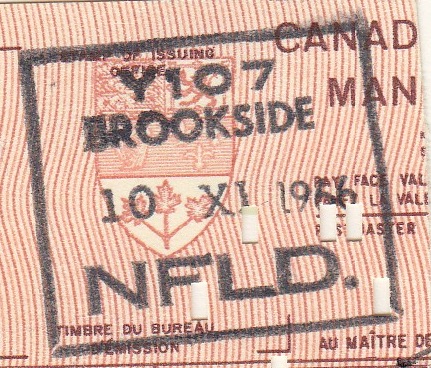
Y107
Brookside, NL
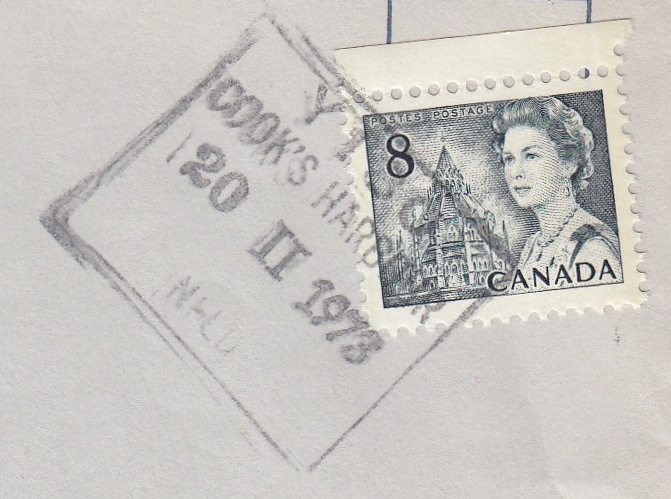
Y180
Cook's Harbour, NL
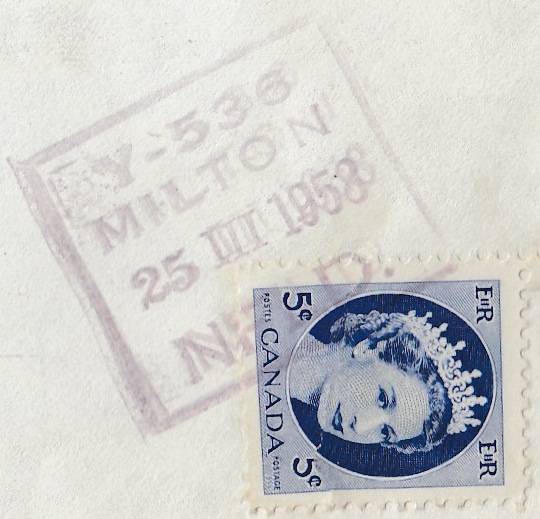
Y536
Milton, NL
Copyright © 2015 - 2025 The British North America Philatelic Society.
The documents on this website are for informational and non-commercial or personal use only.
Documents on this website shall not be used on other websites or for
commercial purposes without permission.
This page was last modified on 2024-04-14.
